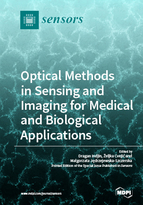Optical Methods in Sensing and Imaging for Medical and Biological Applications
A special issue of Sensors (ISSN 1424-8220).
Deadline for manuscript submissions: closed (15 March 2018) | Viewed by 124695
Special Issue Editors
Interests: optical absorption; semiconductor lasers; mid-infrared and terahertz lasers and detectors; quantum-cascade lasers; infrared and terahertz sensing and imaging, medical sensing and imaging
Special Issues, Collections and Topics in MDPI journals
Interests: structure and microstructure; design and optimization of electrical, magnetic and optical properties of nanomaterials; biomedical structural analysis; X-ray diffraction; Raman spectroscopy and imaging; vibrational spectroscopy; scattering; structure modelling, optometry and vision science
Special Issues, Collections and Topics in MDPI journals
Interests: biophotonics; biomedical optics; fiber-optic sensors; optical sensors; low coherent interferometry
Special Issues, Collections and Topics in MDPI journals
Special Issue Information
Dear Colleagues,
The recent advances in optical sources and detectors have opened up new opportunities for sensing and imaging techniques and biomedical and healthcare applications. This Special Issue of Sensors, entitled "Optical Methods in Sensing and Imaging for Medical and Biological Applications", will focus on all aspects of the research and development related to these areas.
Original research papers that focus on the design and experimental verification of new sensors and imaging system operating in optical spectra, as well as papers that focus on their testing for biomedical and clinical applications, are welcome.
Both reviews and original research articles will be published. Reviews should provide an up-to-date, well-balanced overview of the current state-of-the-art in a particular application and include main results from other groups.
We look forward to, and welcome, your participation in this Special Issue.
Dr. Dragan Indjin,
Dr. Željka Cvejić
Dr. Małgorzata Jędrzejewska-Szczerska
Guest Editors
Manuscript Submission Information
Manuscripts should be submitted online at www.mdpi.com by registering and logging in to this website. Once you are registered, click here to go to the submission form. Manuscripts can be submitted until the deadline. All submissions that pass pre-check are peer-reviewed. Accepted papers will be published continuously in the journal (as soon as accepted) and will be listed together on the special issue website. Research articles, review articles as well as short communications are invited. For planned papers, a title and short abstract (about 100 words) can be sent to the Editorial Office for announcement on this website.
Submitted manuscripts should not have been published previously, nor be under consideration for publication elsewhere (except conference proceedings papers). All manuscripts are thoroughly refereed through a single-blind peer-review process. A guide for authors and other relevant information for submission of manuscripts is available on the Instructions for Authors page. Sensors is an international peer-reviewed open access semimonthly journal published by MDPI.
Please visit the Instructions for Authors page before submitting a manuscript. The Article Processing Charge (APC) for publication in this open access journal is 2600 CHF (Swiss Francs). Submitted papers should be well formatted and use good English. Authors may use MDPI's English editing service prior to publication or during author revisions.
Keywords
sensing mechanisms
biological sensor
chemical sensors
medical sensors
physical sensors
fiber optic sensor
Raman sensing and imaging
spectral imaging
multispectral imaging
computational optical sensing and imaging
imaging spectroscopy
optical medical imaging
optical coherent tomography
optical tomography
optical feedback interferometry









